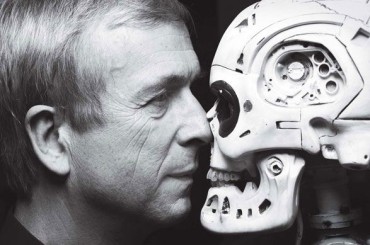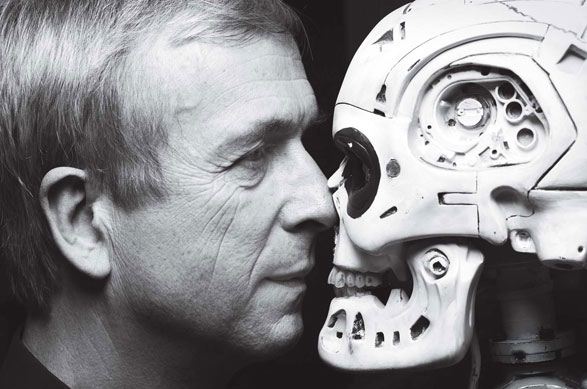Via huliq.com
 It seems the future is almost here now, with Project Cyborg set to unveil an advanced specimen cyborg robot operated by an implanted human brain grown from neurons.
It seems the future is almost here now, with Project Cyborg set to unveil an advanced specimen cyborg robot operated by an implanted human brain grown from neurons.
Famed British scientist Kevin Warwick thinks ?being linked to another person?s nervous system opens up a whole world of possibilities.” For instance, he points to ?thought communication instead of cell phones.? In turn, Warwick stated in the January edition of ?W? (a monthly fashion magazine at wmagazine.com) that he?s about to unveil this ?cyborg? technology soon with his ?most advanced specimen to date: a cyborg robot that will be operated by an implanted human brain grown from neurons.? A ?cyborg? is the nickname for a ?cybernetic organism? ? that?s both biological and artificial, with electronic and mechanical robotic parts. Warwick, who began ?Project Cyborg? in 2002 with a goal, he told W, of making discoveries that can combat Parkinson?s disease, blindness, arthritis, and schizophrenia.? Also, Professor Warwick explains how using ?electronic — as opposed to chemical — medicine may well become the norm.? For instance, ?W? explains how ?taking Advil for a headache numbs the whole body, whereas electronic remedies could treat only the specific area.?
Professor to become a cyborg in 2012
At the same time, Professor Warwick told wmagazine.com that ?he?s not just interested in healing the sick??because he hopes — ?the technology he?s developing will upgrade man?s capacity to do pretty much anything.?
Professor Warwick, 58, also told wmagazine.com that his new cyborg creation will ?end up having about 30 million brain cells, and will be able to teach itself new skills every day.?
At the same time, this professor at England?s University of Reading, also disclosed that he?s initiating ?the third phase of Project Cyborg, which involves ?embedding a more elaborate chip directly into his own brain.?

 Cyborgs already walking the Earth
Cyborgs already walking the Earth
Most fans of Cyborg technology may recall that in 2002 — under the heading Project Cyborg — Warwick had an array of 100 electrodes fired in to his nervous system in order to link his nervous system into the Internet.
According to a news release from the University of Redding, Warwick ?successfully carried out a series of experiments including extending his nervous system over the Internet to control a robotic hand, a loudspeaker and amplifier. This is a form of extended sensory input and the first direct electronic communication between the nervous systems of two humans.?
In turn, an Irish artist named Neil Harbisson is best known as a self-proclaimed ?cyborg.?
Harbisson is best known for his self-extended ability to hear colors and to perceive colors that overstep the bounds of human vision.
Also, Harbisson became ?the first person in the world to wear an ?eyeborg,? states this artist?s press release that goes on to state that ?in 2010, he founded the ?Cyborg Foundation,? a self-proclaimed international organization to help humans become cyborgs.?
Warwick predicts major cyborg breakthroughs
Professor Warwick points to his early work in artificial intelligence, biomedical engineering and robotics as helping him achieve his pioneering science in cyborg technology.
In turn, Professor Warwick presently heads a special engineering and physical sciences think tank that?s supported by the British government to investigate the ?use of machine learning and artificial intelligence techniques in order to suitably stimulate and translate patterns of electrical activity from living cultured neural networks in order to control mobile robots.?
Thus, his recent announcement that ?a biological brain? can actually be put into these ?Terminator? looking cyborg robots that, he predicts, will one day think and act like humans.
While Professor Warwick?s team of cyborg technology scientists hope that their Project Cyborg will lead to new medical tools for treating people with damage to their nervous system, critics fear that he could help create a new type of threat to mankind when, and if his cyborgs become a modern day Frankenstein.
 Warwick on a mission to create cyborgs
Warwick on a mission to create cyborgs
It was 12 years ago, states a recent wmagazine.com report that ?Warwick declared he was on a mission to become the world?s first man-turned-machine. He began this undertaking, dubbed Project Cyborg, in 1998, when he had a microchip embedded in his body, something that had never been attempted before. Surgeons inserted a glass capsule containing several micro-processors into Warwick?s arm, and for the next nine days his presence was recorded by computers throughout the university?s cybernetics department.?
?The implant responded to computer signals,? said Professor Warwick explains in his cramped and chaotic study in England, reports ?W.? In turn, he said: ?Doors opened automatically, lights turned on when I entered a room, and my PC announced ?Hello, Professor Warwick? when I approached. At the time newspapers were reporting that it had run the bath and chilled the wine for me, which sounds awfully nice but sadly wasn?t true. However, it could have done anything had we programmed it accordingly. It could have launched missiles.?
From Project Cyborg?s earliest days, wmagazine.com reported how Professor Warwick?s motives have been scrutinized. ?Was this unassuming Brit pioneering something that would save or destroy mankind? Would he use his knowledge to make possible the sort of monsters that hitherto had been the stuff of B movies??
One thing is certain, added this recent report in ?W,? and that is how ?Warwick?s media-friendly, sky?s-the-limit approach to cybernetics has made him an influential figure. Although skeptics claim that Project Cyborg is more about self-promotion than pioneering science, it remains a case study for science classes at Harvard, Stanford, and MIT.?
For instance, think of the film ?A.I,? with Professor Warwick predicting that one day ?a cyborg community will become a reality.?




